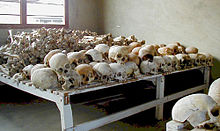- Murambi Technical School
-
The Murambi Technical School, now known as the Murambi Genocide Memorial Centre, is situated in the Murambi district in southern Rwanda. It was the site of a massacre during the 1994 Rwandan genocide. When the killings started, Tutsis in the region tried to hide at a local church. However, the bishop and mayor lured them into a trap by sending them to the technical school, claiming that French troops would protect them there. On April 16, 1994, some 65,000 Tutsis ran to the school. Water and electricity were cut off. After defending themselves for a few days using stones, the Tutsi were overrun on April 21. The French soldiers disappeared and the school was attacked by Hutu Interahamwe militiamen. Some 45,000 Tutsi were murdered at the school, and almost all of those who managed to escape were killed the next day when they tried to hide in a nearby church. According to the guide at the memorial, the French brought in heavy equipment to dig several pits where many thousands of bodies were placed. They then placed a volleyball court over the mass graves in an attempt to hide what happened. After the victims were told to gather there water was cut off and no food was available, so that the people were too weak to resist. Among the bodies currently displayed are many children and infants. When the killers ran out of ammunition they were re-supplied by the French military. [1]
The school building is now a genocide museum exhibiting the skeletons and mummified bodies of some of the thousands of people killed there.References
- ^ "Rwanda Murabi". orwelltoday.com. http://www.orwelltoday.com/rwandamurambi.shtml.
External links
Categories:- African building and structure stubs
- Rwanda stubs
- African museum stubs
- Rwandan Genocide
- Genocide museums
- Mummies
Wikimedia Foundation. 2010.


